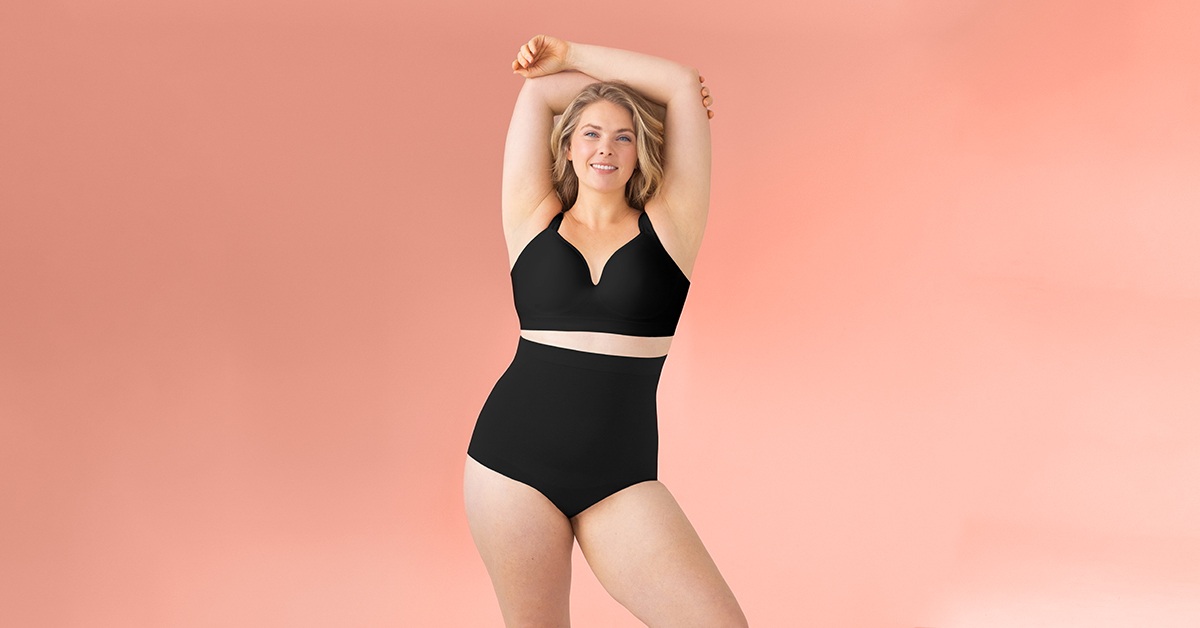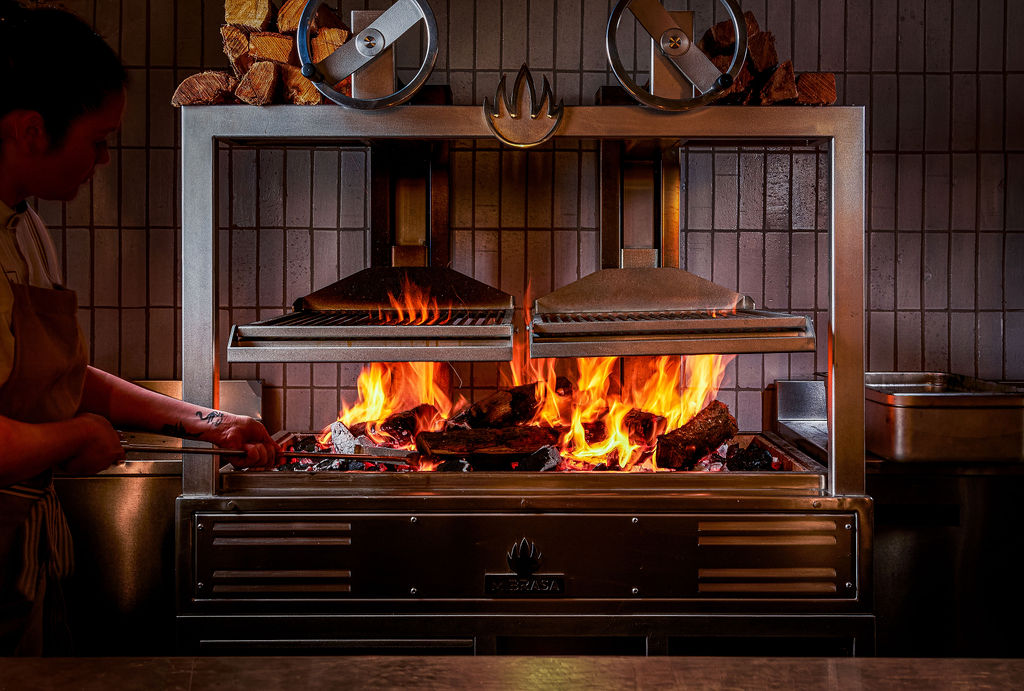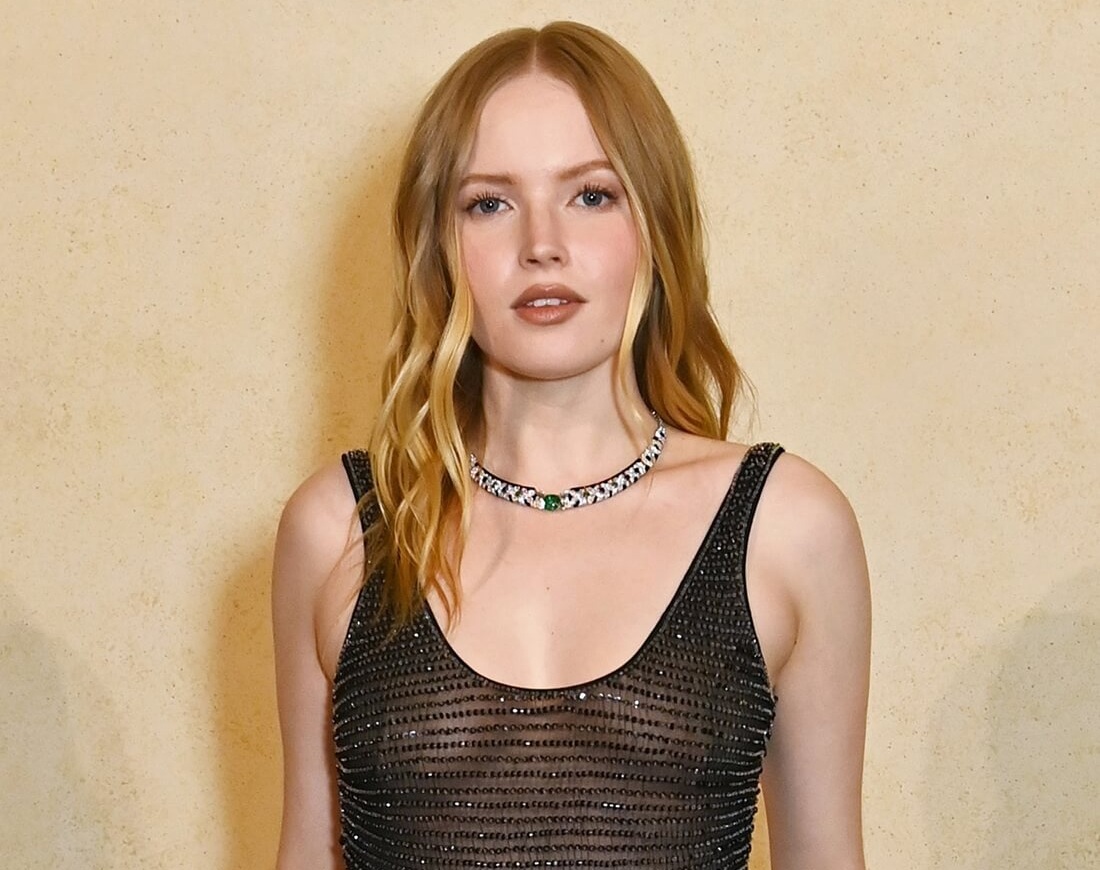Katie Couric’s Advocation For Cancer Screening Paid Off — And May Have Saved Her Life
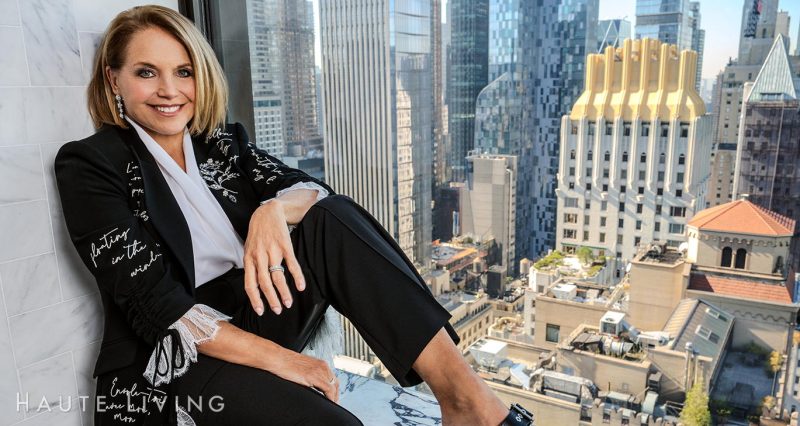
SHIRT: Giorgio Armani PANTS: Adeam
SHOES: Alexander McQueen JEWELRY: Van Cleef & Arpels
Photo Credit: Scott McDermott
BY LAURA SCHREFFLER
PHOTOGRAPHY SCOTT MCDERMOTT
STYLING ERIN MCSHERRY
HAIR LEONARDO MANETTI
MAKEUP MAGDALENA MAJOR
SHOT ON LOCATION AT PARK LANE NEW YORK
Katie Couric’s closest friends call her the “screen queen.” It’s a nickname that she’ll happily own, given that an early detection cancer screening actually saved her life.
She remembers the day well. It was June 21, her eighth wedding anniversary to second husband John Molner, a day of celebration. Until it wasn’t.
Couric, now 66, was six months late for her annual mammogram, a by-product of the still-lingering pandemic. “My breast radiologist said, ‘I don’t love what I’m seeing’ and then she went on to give me a breast ultrasound. Oftentimes, it’s hard to tell if you have an abnormality because the denseness of your breast looks white on a mammogram, and an abnormality also looks white. As my doctor says, it’s like trying to see a snowball against a backdrop of snow. But I was lucky, because I had always gotten ultrasounds in addition to mammograms, and during this particular ultrasound, she needed to do a biopsy to be able to see accurately. And so, on my anniversary, I learned that I had early-stage breast cancer.”
Cancer is something Couric is sadly all too familiar with. She lost both her husband Jay Monahan to colorectal cancer in 1998, and her sister Emily to pancreatic cancer in 2001. As a result of their deaths, she realized that her life’s purpose was to try to eradicate the disease. She has spent over 20 years doing so, co-founding the National Colorectal Cancer Research Alliance in 2000, and later, in 2008, the non-profit Stand Up To Cancer (SU2C). With the collective goal of moving science forward faster, it was founded with eight other Hollywood power players, including former Paramount Pictures CEO Sherry Lansing. SU2C Science has now contributed to the approval of nine new FDA approved drugs.
That she has so much knowledge of cancer treatments and research offered a modicum of comfort. It softened the blow, so to speak. But hearing this kind of news, even for the toughest of cookies (which Couric clearly is) is never a good thing.
“It was a shock,” she admits now, over a year later. “It was destabilizing. The room kind of started moving around. It was scary. And even though we’ve made so much progress in cancer treatment, it was still a pretty scary [diagnosis].”
When the room stopped spinning, she employed some of that typical Katie Couric, silk-behind-steel gumption America has come to know, put on her shit-kicking boots, and got real. “When I looked at my situation compared to other people, I felt very fortunate. I had this foundation of experience. Because I have done so much work in this area, it was less scary and confusing for me. I knew what it meant to be diagnosed when you have metastases on other organs — as was the case with both my husband and sister — and knew that if the cancer was localized, if it wasn’t in my lymph nodes, I was in a good shape. It wasn’t as if I was just being introduced to this world of cancer. I have a pretty deep knowledge of the disease, and an understanding of treatment protocols and therapeutic approaches. Ultimately, I felt very relieved, thinking, This is what it is, and I’ve got this.”
Armed with this knowledge, she believed her doctor when she was told that her cancer was treatable, that she was fortunate, and had the “good cancer.” To break it down, Couric had a hormone receptor positive tumor — meaning that estrogen and progesterone feed the tumor and make it possible to reemerge. Her treatments included lumpectomy and radiation; she is now on adjuvant therapy in the form of aromatase inhibitors, which reduce the amount of estrogen in her body.
Although I don’t understand much of it, that she’s sharing the specifics of her medical trials and tribulations is Couric’s way. She is famous for putting it all out there. No one will forget that she received a colonoscopy on the Today show in 2000 (though some do forget that it wasn’t done live). Nor should they ever forget what happened directly because of this: there was a 20 percent increase in Americans who were screened for cancer after her segment aired, in what the media has dubbed (and which the University of Michigan actually coined) ‘The Couric Effect.’
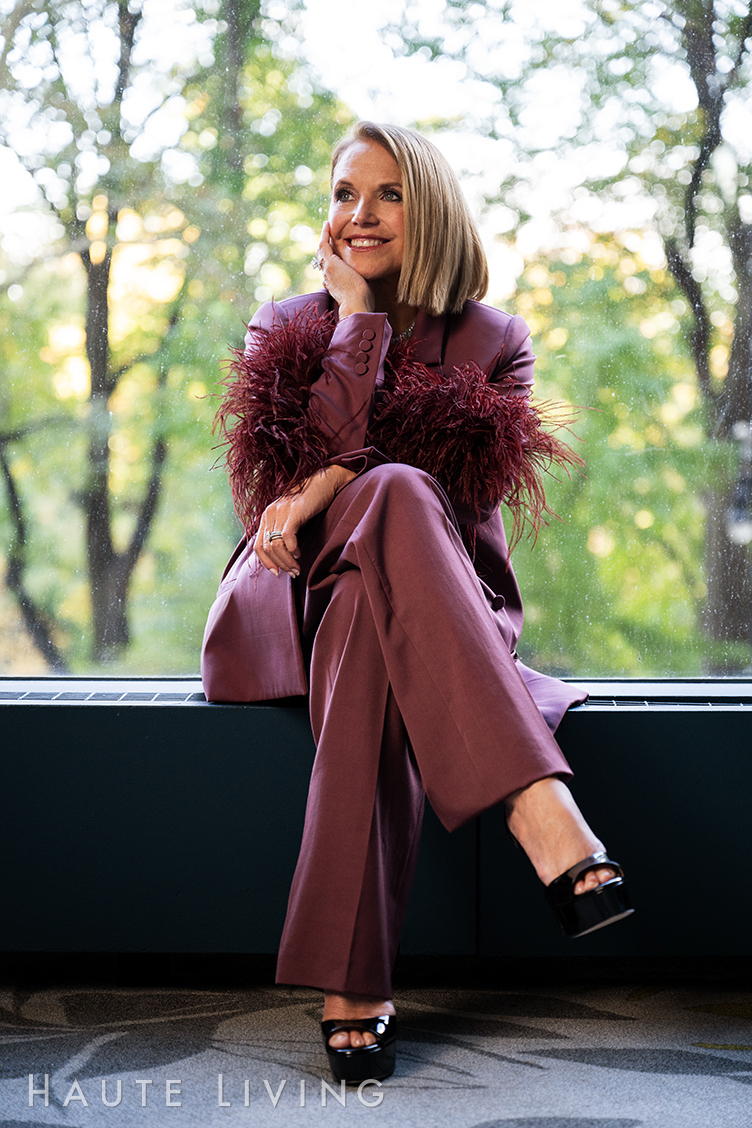
SHOES: Stuart Weitzman JEWELRY: Harry Winston
Photo Credit: Scott McDermott
She explains this moment as such: “When my husband Jay died of colon cancer in 1998 at just 42, I was the co-anchor of the Today show, and realized that there was so much I had learned during the process of his illness that would be invaluable for viewers to know and understand. And because I had gotten such a fast, nine-month-long education — that’s how long it was from diagnosis to when Jay passed away — I felt this obligation to inform the public.”
Ironically, it was doing just that that led to her own breast cancer diagnosis. She wanted to learn and educate more about dense breasts, and decided to draft an article about them for her newsletter, Wake-Up Call. She had planned to visually document the experience and brought her producer to her radiology appointment to do so. “I was going to explain what people with dense breasts needed to do vis-a-vis screening. Of course, I didn’t think I would be diagnosed in the middle of that,” she says ruefully.
Once Couric was aware of her diagnosis, there was never another road to go down — she always knew her news needed to be shared because ultimately it would benefit others. “It made perfect sense that I would be public about this because I’ve been public about so much,” she says in response. “I thought there was a lot of education that needed to happen for women with dense breasts, and I wanted to stress the importance of getting screened. My friends call me the ‘screen queen,’ and it’s true. I’ve seen firsthand now how early detection saves lives. The longer it takes to detect something, the more advanced the cancer is, and the more difficult it is to treat. So, yes, I jumped at the opportunity to help women — and men — who get diagnosed with breast cancer understand how important it is to get regular screenings, to know your family history, to see if you have a genetic predisposition to cancer, and to really be an advocate for your own health.
“I see journalism as a public service, and I started to think about what existed in terms of steps that should be taken if you have dense breasts,” she continues. “And then I started looking into public policy: how women are notified — or not, in many cases — how insurance pays for additional screening —it more often doesn’t — and how to really fix these problems. The FDA changed their rules, and, starting in 2024, there will be a uniform process in which women who have them will be told — not only that they have dense breasts — but what they should do because of them. One of the things I’m trying to do is help reduce that gap for women, and make sure that they all have access to life-saving technology.”
For someone like Couric, sharing her story and advocating for not just her own health, but others, has helped her morale tremendously. She is doing what she knows, and despite her own terrifying diagnosis, working through it this way has been a tremendous comfort. She’s doing the right thing for her body by receiving treatment, and for her mind by treating this like any other thing. It is her life, and her choice.
“I’m a workaholic, whether I was diagnosed with breast cancer or not. [When I received my diagnosis], I vowed to keep doing what I was doing.”
That included telling a lot of stories this past October, for Breast Cancer Awareness Month. “I try to use any platform I have to educate the public, not just about breast cancer, but all sorts of health issues because I want to share what I’m learning. One of the things I’ve mastered through the years is distilling and synthesizing complicated medical concepts and explaining them in simple terms to people. I feel like this is part of my mission: informing people, but doing it in an understandable, accessible way,” she declares.
Talk about a mission. Telling the truth — in all forms — is her raison d’être. “I’m a journalist who strongly believes in trying to give people accurate, trustworthy information, especially now, where there is so much misinformation — there are all kinds of things that get spread and aren’t accurate. I want people to continue to trust me as a source of information. I think I’ve always been an open book, and I have no qualms about sharing my personal story if I believe it will help other people. It took me a long time to talk about my husband, and even my sister, because those are their stories; they weren’t necessarily my stories to tell. But now, I have the benefit of time.”
She fully opened and allowed herself to tell those stories (and others) in her 2021 memoir, Going There, which was cathartic in many ways. “I talked about Jay and Emily a lot in the book. I felt it was time I could share what it was like, not for them, but as someone who was watching people they love die of this disease. When someone you love has cancer and there’s nothing you can do, it’s very frustrating to feel so powerless. I wanted to do something; to take what had happened to us, and try to help other families prevent it from happening to them.”
Though she is someone who has experienced endless amounts of pain, she has had pockets of great joy, too. There is always a silver lining, and she views her own early detection diagnosis as such. “I would have been committed to this for the rest of my life [anyway], but it renewed my commitment to educating people about cancer and supporting research. Before I experienced cancer in my own family, I always wanted to help a lot of charitable causes. I’d emcee things, speak, and contribute, but I never had something that I felt so personally committed to. I think that when you have first-hand experience with something like a disease, it changes your perspective and gives you profound understanding. I wanted to use that knowledge to galvanize a community, support science, and find a cure,” she admits, noting, “I’ve always had purpose, but to really focus on this gave my life an even greater sense of purpose.”

Photo Credit: Scott McDermott
There is very little doubt that, in journalism, Katie Couric is a G.O.A.T. But did you know she’s also a goat — a Capricorn — in the astrological sense?
I take great pride in telling Couric all about her astrological signs —
she’s a Capricorn sun, Aries moon, and Libra ascendant — during our pre-Halloween Zoom.
“All I know is that I’m a Capricorn, a goat, that I like to work hard, and that I’m very motivated. I’m not really into astrology. What does it all mean? I have no idea,” she admits. Nor does she want to know, but I tell her about herself anyway. She is practical at heart, pretty in appearance, and because of this, people tend to think they can get one over on her. But that Aries moon? The woman is all fire if you cross her. Plus, she’s compelled to tell the truth, at any cost.
“You’re a bit of a Crusader,” I say. “Katie the Crusader.”
“Maybe that’s my Aries moon,” she jokes. [As an aside, her funny side is what surprises people the most about her — that, and being able to play the piano by ear.]
Whether it’s written in the stars is up for debate — especially by the endlessly pragmatic Couric, whose Capricorn sun is showing methinks — but that George Washington-esque refusal to tell a lie is something that’s been a part of her personality for as long as she can remember.
She recalls that she and brother John Jr. accidentally broke one of the posts off of her parents’ bed in their Arlington, Virginia home during a pillow fight. “I remember not being honest with my mom,” she says of her mother, Katherine, a homemaker and part-time writer. “I think my brother Johnny and I tried to glue it, but we did not come clean. I’m the kind of person who is filled with unbearable guilt by hiding something; I’ve always been like that. I remember she was just standing there, washing dishes after dinner, and I had to tell her the truth. She didn’t get mad. She said, ‘Thank you for being honest with me.’”
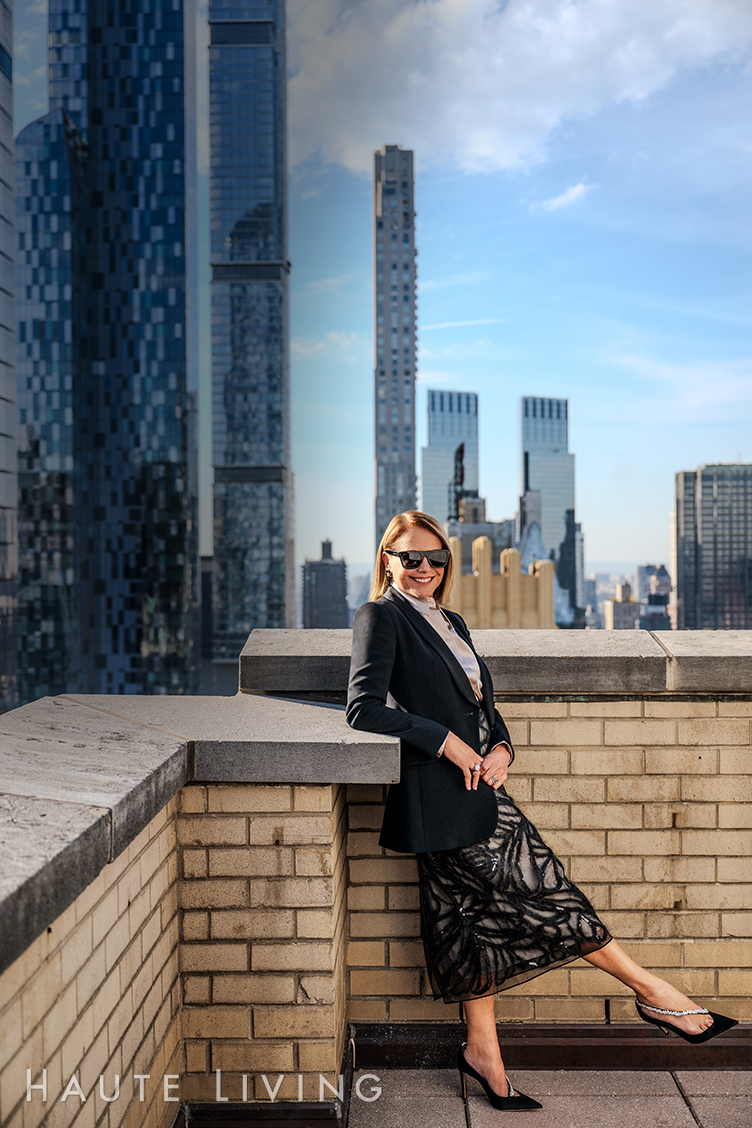
SHOES: Giuseppe Zanotti JEWELRY: Van Cleef & Arpels
SUNGLASSES: Dolce & Gabbana
Photo Credit: Scott McDermott
It makes sense that Couric — by virtue of her star chart or not — would dedicate her life to a relentless pursuit of the truth.
“When you’re a journalist, your whole profession is built on telling the truth and reporting what is going on. I’ve always been motivated that way, but I wouldn’t say I would tell the truth at all costs. There’s a balance; it depends on what you’re talking about. There are personal truths, and there are professional truths. You always have a choice of what you share with other people. It’s admirable to be a truth teller, but not if it’s going to hurt somebody,” she notes.
This sense of integrity must be part of the reason Couric is so successful. For starters, she was the first woman to solo anchor a network, and then, one of the highest paid anchors in history. She’s also won a slew of prestigious accolades, including an Alfred I. duPont-Columbia, two Peabody Awards, two Edward R. Murrow Awards, a Walter Cronkite Award, multiple Emmys. She has been named one of Time magazine’s 100 most influential people twice.
But that comes with the territory when you’ve put in the work to become one of the best. Her résumé is both breathtaking and intimidating. Her first job for the ABC News bureau in Washington, D.C. in 1979 was followed by stints at CNN as an assignment editor, a general assignment reporter for then-CBS affiliate WTVJ in Miami, and as a reporter for the NBC-owned WRC-TV in D.C., where she was working when she earned her first Associated Press award and an Emmy. Couric then moved to NBC News, first as the deputy Pentagon correspondent, and then as a national correspondent for the Today show, as well as substitute news anchor (at Today and NBC News at Sunrise). She became a permanent co-anchor on Today in 1991 when Deborah Norville did not return, as well as co-anchor of Now with Tom Brokaw and Katie Couric in 1993. She remained at Today and NBC News for 15 years until she announced she would be moving to CBS to anchor the CBS Evening News in 2006, where she became the first solo female to anchor one of the “big three” nightly news broadcasts, as well as the highest paid journalist in the world. Talk about breaking glass ceilings.
During her tenure at CBS, Couric won the 2008 and 2009 Edward R. Murrow Award for best newscast. In 2009, she also took home the Emmy Governor’s Award for her broadcasting career, and in 2010, won an Emmy for her exclusive interview with Captain Sully Sullenberger, the hero pilot of US Airways Flight 1549 that landed on the Hudson River.
She returned to ABC News from 2011 to 2013 as a special correspondent, while simultaneously hosting the daytime talk show, Katie. That same year, then-Yahoo! CEO Marissa Mayer hired Couric as a global anchor of Yahoo! News, where she remained until 2017 after Verizon purchased the site. But it wasn’t until 2017 that she began to really steer her own ship, and work entirely for herself, on her terms, by creating Katie Couric Media (KCM). There, she works steadily alongside husband of nine years John Molner to develop a slew of media projects, including the daily newsletter Wake-Up Call, the podcast “Next Question with Katie Couric,” multiple digital video series, and several documentaries. Over the years, she has produced Fed-Up About the Obesity Epidemic, Gender Revolution: A Journey with Katie Couric, for National Geographic; Under the Gun, which aired on Epix; and the six-part series America Inside Out with Katie Couric. She works with purpose-driven brands to create premium content that addresses important social issues like gender equality, environmental sustainability, and mental health.
“One of the things that is fun for me now is to create job opportunities to give people a chance to find their passion, to grow in a job, and to explore things they’re interested in. I want people to love their work as much as I’ve loved my work, and to provide that place where they’ll find that love.”
She’s confident she will succeed where many others haven’t because KCM has responded to and been able to adapt to trends. “Certain networks have clung to the old model of linear television, which has been declining year after year. For me, this has been an interesting business model, and a fascinating learning experience.”
She cites learning about things she was previously unfamiliar with, like podcasts, Instagram Lives, and even TikTok (of which I’m gently chastised about my ignorance) as ways she’s managed to roll with the current times and stay relevant. “We can’t wait for opportunities; we have to create them. I think that’s something everyone is capable of. You have to pay attention to what’s going on, how trends change, and then figure out how to adapt, because if you don’t, you’re going to be left behind.”
After the career she’s had, working for herself and doing exactly as she wants to do feels unreal. “Having the flexibility to work for myself is a luxury,” she confesses.
She’s come to this conclusion, but only after literally Googling the meaning of luxury on her iPhone.
Couric thoughtfully pushes her gold-rimmed glasses higher on her nose and wonders aloud, “What is the definition of luxury? I’m going to look this up.” Her phone reveals that luxury is “a condition of abundance or great ease and comfort,” and that “most people define luxury as having access to the nicest things life can offer” or “something that gives pleasure or comfort to an individual but is not necessary.”
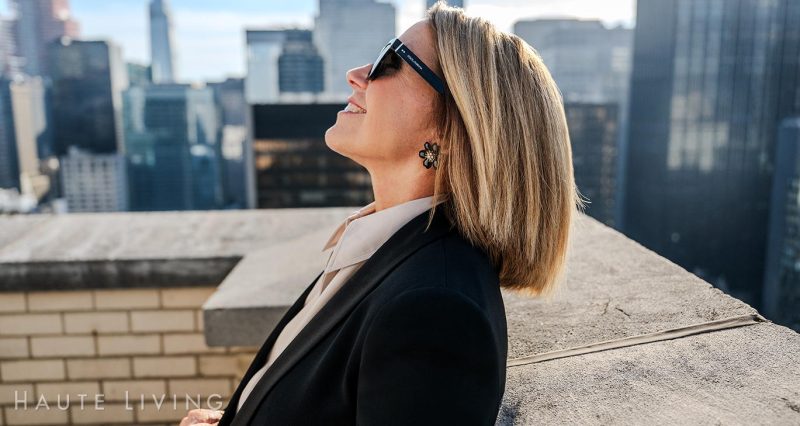
Photo Credit: Scott McDermott
She pauses, and admits that she disagrees with this definition, and has, while speaking, been searching for others that feel more accurate. “A better definition is this: luxury is defined as something that ‘gives pleasure or comfort to an individual but is not completely necessary.’ The synonyms they give are affluence, comfort, enjoyment, extravagance, leisure, and opulence. I don’t really agree with these.” She shakes her head. “I think a luxury is something that’s special; it doesn’t always have to do with wealth and having the nicest things. [And so, for me, the greatest luxury in life would be] ‘time’ because it is a luxury. After all, it can be scarce. It’s a necessary commodity to have a life worth living, right? If you don’t have time to be with the people you care about, or pursue the things you love, then your quality of life is simply not as good.”
For Couric, these days, that rare, fleeting time is time well spent with the people she loves — her husband, her daughters Elinor and Caroline, and her circle of girlfriends; playing the piano (“The Way You Look Tonight” is a particular favorite); taking baths; walking in Central Park; going to a Broadway show; or painting watercolors when the mood strikes.
“I’m happy,” she confides. “I’m trying to appreciate every day. My husband always jokes that we’re on the back nine. And I always say, ‘Thankfully, I’m playing with a good set of clubs.’ I’m trying to make sure I’m not putting off great life experiences. I’m going to Patagonia in February with my husband. I went to a University of Alabama football game because I’ve never been to a big game like that. I’m spending quality time with my friends and making sure that every day counts. While I want to enjoy my life, I also really want to put important things out in the world. I’m starting a production company to work on more documentary projects, along with everything we’re doing at Katie Couric Media, but I’m trying to find the right balance, that elusive work-life balance. Luckily, my work has always been integrated seamlessly with my life — it satisfies my insatiable curiosity to learn and understand things. I’m one of those fortunate people that picked a profession they love, one that’s never really felt like work.”
She stops for a moment and smiles, her famously big, mega-watt, evening news, morning news, and everything in between smile, and offers up another piece of advice. “Having control over your destiny is everything, and that’s where I am now. I make decisions about what I do. Nobody can tell me that I have to do an interview about any particular movie. If I think the movie is terrible and I wouldn’t want people to waste their time on it, I just don’t have to do it. Before, a lot of the decision-making wasn’t mine. But I am the boss of me, as my daughters would have said when they were little. That’s a good feeling. And that is a luxury.”

JEWELRY: Cartier
Photo Credit: Scott McDermott

